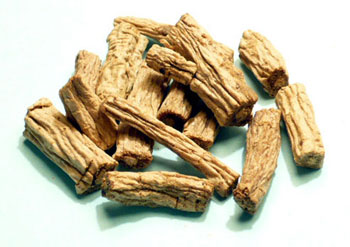Although not a ginseng at all, codonopsis has similar tastes, energies and tonifying properties as ginseng. As well, both herbs affect the Lung and Spleen organs and meridians. Yet, because it is milder in action and far less expensive, codonopsis is often called the ‘poor man’s ginseng.’ Because the body’s fires are rising up and out during the summertime, it’s important to switch from using ginseng to codonopsis. Its milder energy is more appropriate for hotter weather and so traditionally is substituted for ginseng in the summer. Partly this may be due to codonopsis not having the potential to stagnate energy as easily as does ginseng, but also because it lowers blood pressure while ginseng elevates it. Excess heat in the body not only can congest energy, but it rises as well, just as steam rises from a fire. The strong tonifying action of ginseng more easily congests already stagnant energy, which is why it is most always given along with a qi-moving herb. And in the summer, higher outside temperatures can combine with our own inner fires rising upward and outward to create more inner heat if it is not naturally dispersed through activity, sweating and a cooler diet. Ingesting strong tonic herbs in the summer can congest that heat and lead to many unpleasant symptoms. Some also believe that codonopsis tonifies blood as well as qi and promotes the production of body fluids, making it particularly useful for women. It is even beneficial for nursing mothers as it helps produce milk and its nutrients are especially nourishing to babies. Furthermore, it’s useful for teething babies, as its hard, sweet tasting root can be held like a stick. When combined with astragalus, it builds immunity, helpful during the weather changes in Spring. It may be given along with exterior-releasing herbs (diaphoretics) for colds and flu in those who are weak. Its mild action makes it acceptable for children to take as well, helping build muscle and strengthen the digestive, immune and respiratory systems. According to Ron Teeguarden, ‘Codonopsis has been demonstrated to have radiation protection activity and can be effective in protecting cancer patients receiving radiation therapy from the side effects without diminishing its benefits. Codonopsis also has interferon-inducing activity that may be of importance in many immune deficiency conditions, including HIV infection.’ Include codonopsis in a weekly tonic soup or morning cereal as a general tonic.
Codonopsis pilosulae
Family: Campanulaceae Pin yin: dang shen Part Used: root Energy, taste and Organs affected: neutral; sweet; Lungs, Spleen Actions: tonifies Qi Properties: energy tonic, demulcent, expectorant Biochemical constituents: saponin, starch, sugar, inulin, alkaloids, sucrose, glucose Dose: 9-30 g, decoct for 20-30 minutes; eat root after cooking Precautions: do not use with veratri (li lu) Other: codonopsis is frequently substituted for Chinese ginseng Indications: lack of appetite, fatigue, tiredness, weakness, poor digestion, gas, weak arms and legs, bloatedness, diarrhea, vomiting, prolapse of uterus, stomach or rectum, chronic cough, shortness of breath, copious white to clear mucus Uses: Codonopsis is a primary herb used to tonify Qi, particularly of digestion (the Spleen) and immunity (the Lungs). It is similar to Chinese ginseng, but milder in energy and actions (and cheaper, too!) and so is safe for long-term treatment, in all climates (it is typically given in summer rather than ginseng) and by both sexes. Codonopsis increases vital energy, strengthens digestion and assimilation and treats diabetes and hyperacidity. It is given in all diseases associated with weakness, debility after illness, tiredness, lack of strength, poor appetite and anemia. It also alleviates diarrhea, vomiting, gas, bloatedness, chronic cough and shortness of breath.

